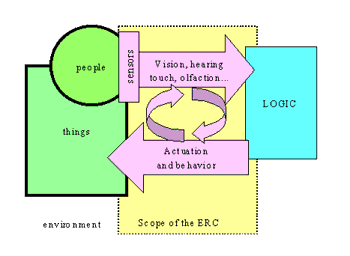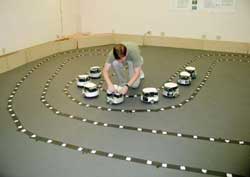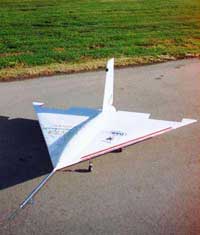
Center for Neuromorphic Systems Engineering
California Institute of Technology
![]()
Endowing machines of the next century with human senses
| A National Science Foundation Engineering Research Center since 1993 |
In the Center for Neuromorphic Systems Engineering (CNSE), we envision a future where machines sense, interact with, learn from, and adapt to their environment with the same ease as living creatures do now. This generation of smarter machines will greatly improve consumer products, human/computer interaction, healthcare, manufacturing, and telecommunications. In addition, new industries will be created to produce and support these intelligent machines.
Research
Computers are becoming faster and cheaper. Unfortunately, the sensory systems by which machines acquire information about their environment have not improved at nearly the same pace: most machines need a human 'master' to tell them what to do via knobs, sliders, keyboards and pointing devices. This is because building artificial sensory systems is a very difficult engineering problem. The CNSE's approach to sensory system design is to be inspired by biology. We follow the lead of nature by developing special-purpose systems for specific sensory processing tasks. By trading off generality, we can achieve high-performance sensory systems that are low cost, require low power, and can be miniaturized. When these special-purpose sensors and processing electronics are coupled with learning algorithms and appropriate computational architectures, the resulting integrated sensory system can offer robustness to environmental variations and useful performance over a very wide range of input magnitude. Such sensory systems are key to the future realization of intelligent and interactive systems. Our emphasis on sensing as a pathway to intelligence is a distinct and healthy alternative to the Artificial Intelligence- and logic-based approaches that have not lived up to their promise.
 To
realize this vision of smart sensory-based systems, we have forged multidisciplinary
collaborations involving biologists, neuroscientists, engineers, and business
people from academia and industry. The mission of the CNSE is to develop
the infrastructure of neuromorphic technology and expertise that enables
this revolutionary enhancement in machine capability. This infrastructure
includes technology and expertise in neurobiology, biomimetics, low-power
analog VLSI implementations, optoelectronics, integrated micromechanical
sensors and actuators, reconfigurable circuits, artificial neural network
learning algorithms and architectures, event-driven communication, sensor-based
feedback control theory, autonomous planning, and integration of learning
and adaptation into algorithms and hardware. Our goal is to integrate
these tools into a new design methodology that will result in major advances
in human-machine interfaces, smart products, and autonomous machines.
To
realize this vision of smart sensory-based systems, we have forged multidisciplinary
collaborations involving biologists, neuroscientists, engineers, and business
people from academia and industry. The mission of the CNSE is to develop
the infrastructure of neuromorphic technology and expertise that enables
this revolutionary enhancement in machine capability. This infrastructure
includes technology and expertise in neurobiology, biomimetics, low-power
analog VLSI implementations, optoelectronics, integrated micromechanical
sensors and actuators, reconfigurable circuits, artificial neural network
learning algorithms and architectures, event-driven communication, sensor-based
feedback control theory, autonomous planning, and integration of learning
and adaptation into algorithms and hardware. Our goal is to integrate
these tools into a new design methodology that will result in major advances
in human-machine interfaces, smart products, and autonomous machines.
 |
| CNSE research in "swarm intelligence" applies principles learned from the behavior of social animals, such as ants or birds, to groups of robots that act collectively to perform a given task. As an example, we are developing a complementing automotive controller that improves upon the driving experience. This controller operates to avoid collisions, enforce a smooth trajectory, and deliver the vehicle to the intended destination as quickly as possible. The controller will monitor certain road conditions and will override the human driver only in emergency situations. |
On the industrial front, our goal is to create a neuromorphic engineering industry. We are striving toward this goal in two ways. First, we are successfully spinning off start-up companies that can quickly bring specific CNSE technologies to market. Second, we work with established companies to find ways that the center's technologies and design methodologies can be introduced into their products and engineering processes. Our work will impact the US and world economy very broadly in the long term. Machines that are endowed with senses and autonomy can be better interfaced with people and their environmentthey will not be passive tools, but active helpers. This will deeply affect products in industries as diverse as consumer electronics, automotive, computer, entertainment, home appliances, machinery for manufacturing and inspection, medical devices, and medical prostheses, to name a few. In the short term, we will impact a well-selected small set of products and markets. Biometrics, touch pads, and artificial noses are early examples of areas where the center has already had an impact. Future products will likely include: MEMS micro-fluids sensors, MEMS microphones, ultra-fast sensors, novel robotic systems, biomimetic graphical user interfaces, novel tools for surgery, and neuroprosthetic devices.
Education
 |
| The MEMS group within the CNSE is working towards the reconnaissance aircraft of the future. It is a novel tailless, flying wing design with no conventional control surfaces. Instead, it uses MEMS sensors and actuators along with microelectronics (an M3 system) for flight control. This design has many possible advantages over conventional fixed wing aircraftincluding high maneuverability, low observability, low power, and compact packagingwhich make it ideal for unmanned low-altitude surveillance applications. |
The ERC is a part of the Computation and Neural Systems (CNS) doctoral program at Caltech. The program's chief goal is to examine the fundamental relationships between the structure of neuronal and neuron-like circuits and the computations performed either by living neural elements or by synthetic physical devices. It fosters exchange of ideas and collaborations among engineers, neuroscientists, and theoreticians. The Center also supports the Minority Summer Undergraduate Research Fellowship (MURF) program, which provides support for talented undergraduates to spend a summer working in a research laboratory. The MURF program is aimed at improving the representation of African Americans, Hispanics, Native Americans, and Pacific Islanders in the biological, engineering, and chemical sciences in the United States.
Industrial Collaboration/Technology Transfer
The Center promotes active partnerships with U.S. industry on a number of managerial, educational, and technical levels, all consistent with the mission of the Center. Industry participation occurs through three support groups with increasing levels of involvement: the Caltech Industrial Associates Program, which provides initial access to general ERC information; the ERC Affiliates Program for companies with a general interest in neural networks, who will participate in ERC activities and have limited access to Center facilities and seminars in order to propose specific collaborative projects; and the ERC Members Program for companies seeking more substantive collaborations and Center involvement. These members provide management input to the Center to help define research thrusts; they collaborate with faculty; and they are provided space at the ERC for their visiting engineers and scientists.
Facilities
The Center for Neuromorphic Systems Engineering is located at the California Institute of Technology, one of the world's premier research institutions. The Center occupies approximately 40,000 sq. ft. of space in the Gordon and Betty Moore Laboratory of Engineering. This $21 million, state-of-the-art engineering facility is the focal point for Center activities. In addition to faculty research areas and teaching and student laboratories, there are two laboratories a VLSI design lab and a vision processing lab specifically intended for industrial collaborative projects.
![]()
Center Headquarters
Center for Neuromorphic Systems Engineering
California Institute of Technology
Mail Code 136-93
1200 E. California Boulevard
Pasadena, CA 91125
Tel (626) 395-6254 · Fax (626) 795-4765
Homepage: http://www.erc.caltech.edu
Center Director: Dr. Pietro Perona
(626) 395-4867 · director@erc.caltech.edu
Deputy Director: Dr. Joel W. Burdick
(626) 395-4139 · director@erc.caltech.edu
Manager, Technology Transfer: Dr. Dean Schonfeld
(626) 395-2246 · dean1@sunoptics.caltech.edu
NSF 00-137p